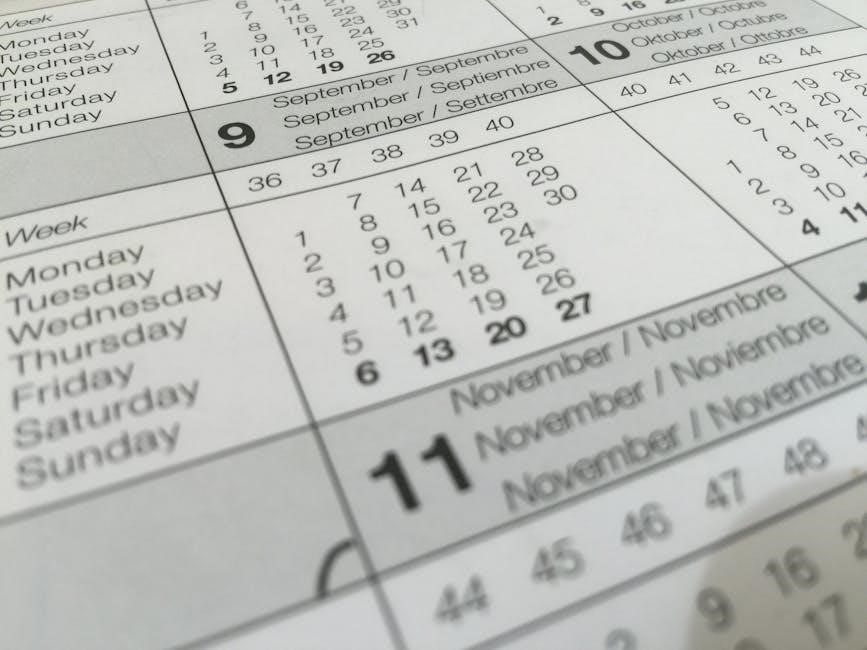Discover a diverse range of Spanish novels in PDF format, from classic works by Cervantes to modern authors like García Márquez, all easily accessible for free download.
Overview of Spanish Literature in Digital Format
Spanish literature in digital format has revolutionized access to classic and modern novels, offering readers a vast library of works in PDF. Platforms like Elejandría, Casa del Novela, and Booknet provide free downloads of novels by renowned authors such as Cervantes, García Márquez, and Allende. These digital libraries ensure that Spanish literature reaches a global audience, promoting cultural enrichment and education. With convenient access to public domain works and legally shared content, readers can explore timeless stories and contemporary narratives effortlessly.
Why Spanish Novels in PDF Are Popular
Spanish novels in PDF have gained immense popularity due to their accessibility and convenience. Readers can easily download and carry hundreds of titles on their devices, making them ideal for travel or daily commutes. Additionally, many classic and modern works are available for free, catering to budget-conscious readers. The digital format also supports multilingual learners and Spanish-language enthusiasts worldwide, fostering a broader appreciation for Hispanic culture and literature. This ease of access has contributed significantly to their global appeal and popularity.

Popular Platforms for Downloading Spanish Novels
Platforms like Elejandría, Casa del Novela, and Booknet offer free Spanish novels in PDF, providing easy access to diverse literary works without registration or costs.
Elejandría: A Comprehensive Library of Free Novels
Elejandría offers a vast collection of free novels in PDF, EPUB, and MOBI formats, all legally available for download without registration. With over 2,000 titles, including classic works by authors like Cervantes and modern novels, the platform caters to diverse literary tastes. Its user-friendly interface allows easy browsing by genre, author, or collection. Elejandría also uses AI to recommend books based on user preferences, making it a go-to destination for book lovers seeking high-quality, accessible literature.
Casa del Novela: Direct Downloads Without Registration
Casa del Novela provides a seamless experience for downloading Spanish novels in PDF format without requiring registration. Users can access a wide variety of books with just one click, ensuring convenience and accessibility. The platform focuses on offering high-quality literature, including classic and contemporary works, making it an ideal choice for readers seeking effortless and quick access to their favorite Spanish novels online.
Booknet: A Vast Collection of Free Books
Booknet offers an extensive library of over 40,000 free books, including Spanish novels, available for easy download or online reading. With a user-friendly interface, it provides access to a wide range of genres, from classic literature to contemporary works. The platform supports reading on various devices, making it ideal for mobile users. Booknet’s diverse collection, including works by authors like Agatha Christie and Calderón de la Barca, ensures there’s something for every reader’s preference, all accessible without registration.

Key Authors of Spanish Novels Available in PDF
Explore renowned authors like Miguel de Cervantes, Gabriel García Márquez, and Isabel Allende, whose iconic works are widely available in PDF format, enriching Spanish literature globally.
Miguel de Cervantes: The Father of Spanish Literature
Miguel de Cervantes, a towering figure in Spanish literature, is celebrated for his timeless masterpiece, “Don Quixote”, a foundational work in world literature. His writings, including “Novelas Ejemplares” and “The Travels of Persiles and Sigismunda”, showcase his profound insight into human nature. Cervantes’ works, now in the public domain, are widely available in PDF format, allowing readers to access his genius freely. His legacy extends beyond literature, influencing art, culture, and philosophy globally.
Gabriel García Márquez: Magical Realism in Spanish
Gabriel García Márquez, a Nobel Prize-winning author, revolutionized literature with his unique style of magical realism. His iconic novel, “One Hundred Years of Solitude”, captivates readers with its blend of fantasy and reality. Other notable works, such as “Love in the Time of Cholera” and “Chronicle of a Death Foretold”, are also widely admired. His novels, now available in PDF format, continue to enchant readers globally, offering a gateway to the rich cultural tapestry of Latin America and the magic of his storytelling.
Isabel Allende: Bestselling Novels in Spanish
Isabel Allende, a renowned Chilean author, captivates readers with her captivating storytelling and rich emotional depth. Her iconic novel, “The House of the Spirits”, explores themes of love, family, and political upheaval. Other notable works, such as “Eva Luna” and “Daughter of Fortune”, blend history, romance, and adventure. Her novels, widely available in PDF format, offer readers a seamless way to immerse themselves in her vivid worlds, making her one of the most beloved Spanish-language authors globally.

Popular Spanish Novels in PDF Format
Explore a wide selection of Spanish novels in PDF, including timeless classics like Don Quixote and contemporary bestsellers, all easily accessible for free download online.
“Don Quixote” by Miguel de Cervantes
Don Quixote, written by Miguel de Cervantes, is a foundational work of Western literature. This timeless tale follows the adventures of Don Quixote and his squire, Sancho Panza, as they navigate a world of chivalric illusions and harsh realities. Exploring themes of madness, reality, and the human condition, this classic novel remains a cornerstone of Spanish literature. Available in PDF format, it can be downloaded for free from platforms like Elejandría and Casa del Novela, ensuring its accessibility to readers worldwide.
“One Hundred Years of Solitude” by Gabriel García Márquez
One Hundred Years of Solitude is a masterpiece of magical realism by Gabriel García Márquez. Set in the fictional town of Macondo, the novel traces the fortunes and misfortunes of the Buendía family, exploring themes of fate, solitude, and the cyclical nature of time. Rich in vivid imagery and profound symbolism, this iconic work is widely regarded as a cornerstone of Latin American literature. Available in PDF format, it can be downloaded from platforms like Booknet and Elejandría, making it easily accessible to readers worldwide.
“The House of the Spirits” by Isabel Allende
The House of the Spirits by Isabel Allende is an epic tale of love, family, and politics, spanning generations of the Trueba family. Set against the backdrop of Chile’s turbulent history, the novel intertwines magical realism with vivid storytelling. Its complex characters and emotional depth have made it a global bestseller. Available in PDF format, this masterpiece can be downloaded from platforms like Casa del Novela and Booknet, offering readers a convenient way to explore Allende’s captivating narrative.

Benefits of Reading Spanish Novels in PDF
Spanish novels in PDF offer unmatched accessibility, convenience, and affordability. They enable readers to enjoy classic and modern literature anywhere, anytime, while supporting eco-friendly and cost-effective reading habits.
Accessibility and Convenience
Spanish novels in PDF format are highly accessible, allowing readers to download and enjoy books instantly. Platforms like InfoLibros and Casa del Novela offer direct downloads without registration, making it easy to start reading. PDFs are compatible with various devices, ensuring portability and flexibility. This format enables readers to access literature anytime, anywhere, without the need for physical storage. The convenience of digital novels promotes a seamless reading experience, catering to diverse preferences and schedules, while also supporting legal and free access to quality literature.
Free and Legal Downloads
Spanish novels in PDF are often available as free and legal downloads, thanks to platforms like Elejandría and Casa del Novela. These sites specialize in public domain works or books with open licenses, ensuring legal access. Readers can explore classic and modern titles without copyright concerns. The convenience of free downloads fosters a culture of accessibility, allowing everyone to enjoy quality literature. This model supports both authors and readers by promoting free and lawful sharing of literary works, making Spanish novels widely available to global audiences.
Environmentally Friendly Option
Downloading Spanish novels in PDF format is an eco-friendly choice, reducing the need for paper and minimizing carbon emissions from printing and transportation. Digital books allow readers to access multiple titles on a single device, conserving space and resources. This option supports sustainability while maintaining easy access to literature. By choosing PDFs, readers contribute to a greener future without compromising on the joy of reading. Digital libraries like Elejandría and Casa del Novela further promote this eco-conscious approach to book consumption.

Classic vs. Modern Spanish Novels
Spanish novels in PDF format offer a rich contrast between timeless classic themes and contemporary storytelling, catering to readers seeking both traditional and modern literary experiences.
Timeless Themes in Classic Novels
Classic Spanish novels in PDF explore universal themes like love, honor, and social justice, resonating across generations. Works like “Don Quixote” and “Tres novelas ejemplares” delve into human nature and morality, while others, such as “El hermano Juan o el mundo es teatro”, reflect societal critiques. These stories, now accessible in digital formats, continue to captivate readers with their enduring relevance and profound insights into the human condition, making them essential reads for anyone exploring Spanish literature.
Contemporary Issues in Modern Novels
Modern Spanish novels in PDF often address current societal challenges, such as identity, social inequality, and political upheaval. Authors like Isabel Allende and Gabriel García Márquez blend magical realism with contemporary themes, exploring family dynamics, love, and isolation. These works, available through platforms like Booknet and Elejandría, resonate with today’s readers by reflecting modern struggles while maintaining a deep connection to cultural heritage, making them both relatable and thought-provoking for a global audience.

Spanish Romance Novels in PDF
Spanish romance novels in PDF are widely popular, offering emotional depth and passionate stories. Platforms like Booknet and Elejandría provide free downloads, catering to fans of romantic fiction.
Best Romantic Novels to Download
Discover captivating Spanish romantic novels in PDF, perfect for emotional escapes. Platforms like Booknet and Elejandría offer free downloads of timeless classics and modern tales. From passionate dramas to heartfelt love stories, these novels showcase rich narratives and relatable characters. Popular titles include El Amor en los Tiempos del Cólera and La Sombra del Ciprés, ensuring a diverse selection for romance enthusiasts. Explore these stories and immerse yourself in the beauty of Spanish romantic literature, all conveniently available in digital format.
Authors Specializing in Romance
Explore the works of renowned Spanish authors who excel in crafting romantic narratives. Writers like Corín Tellado and Javier Sierra captivate readers with their emotional depth and intricate love stories. Their novels, often available in PDF format, blend passion, drama, and cultural richness. Platforms like Booknet and Elejandría offer free downloads of their works, making it easy to enjoy these timeless tales. Dive into the world of Spanish romance through these talented authors’ contributions to the genre.

Spanish Novels for Young Adults
Engaging Spanish novels in PDF format cater to young adults, offering relatable themes, adventure, and contemporary issues. Explore vibrant stories that resonate with youthful experiences and emotions.
Popular YA Novels in Spanish
Young adult readers can explore a variety of engaging Spanish novels in PDF format. Titles like La Sombra del Viento by Carlos Ruiz Zafón and El Laberinto de los Espíritus captivate with mysterious and emotional journeys. La Ciudad de los Prodigios by Eduardo Mendoza and El Cuaderno de Maya by Isabel Allende are also favorites. These stories, available for free download on platforms like Booknet and Elejandría, delve into themes of identity, adventure, and coming-of-age, resonating deeply with young audiences in Spanish-speaking communities and beyond.
Themes and Genres Appealing to Young Readers
Spanish YA novels often explore themes of identity, coming-of-age, and self-discovery, resonating deeply with young audiences. Genres like fantasy, adventure, and romance are particularly popular, offering escapes into magical worlds or relatable emotional journeys. Stories about friendship, family, and overcoming challenges are also prevalent, making these novels accessible and engaging for teenagers. The availability of these works in PDF format ensures that young readers can easily access and enjoy these captivating stories, fostering a love for Spanish literature and diverse storytelling traditions.

The Impact of Digital Libraries
Digital libraries have revolutionized access to Spanish novels, offering free and legal downloads globally. Platforms like Elejandría, Casa del Novela, and Booknet provide diverse works, fostering a love for literature and empowering authors.
How Digital Libraries Promote Spanish Literature
Digital libraries play a crucial role in promoting Spanish literature by making classic and contemporary works widely accessible. Platforms like Elejandría, Casa del Novela, and Booknet offer free, legal downloads of novels in PDF, ensuring global reach. These libraries preserve timeless classics while introducing readers to modern authors, fostering a love for Spanish literature. With features like curated collections and user-friendly interfaces, they empower readers to explore diverse genres and support emerging writers, creating a vibrant community around Spanish literary heritage.
Global Accessibility of Spanish Novels
The rise of digital libraries has made Spanish novels accessible worldwide, breaking geographical barriers. Platforms like Elejandría and Casa del Novela offer free, legal downloads in PDF, enabling readers globally to explore Spanish literature. This accessibility fosters cultural exchange, allowing diverse audiences to engage with classic and contemporary works. With novels available on various devices, from smartphones to e-readers, Spanish literature reaches readers in every corner of the world, promoting its rich cultural heritage on an unprecedented scale.

A Guide for New Readers
Start your journey with popular Spanish novels like Don Quixote or One Hundred Years of Solitude. Explore free platforms like Elejandría or Casa del Novela for easy downloads.
Where to Start with Spanish Novels
Begin your exploration of Spanish novels by visiting platforms like Elejandría or Casa del Novela, which offer free and legal downloads in PDF format. These platforms provide access to classic works like Don Quixote by Miguel de Cervantes and modern masterpieces like One Hundred Years of Solitude by Gabriel García Márquez. Start with these iconic novels to gain a deep understanding of Spanish literature and its rich cultural heritage. This approach ensures a smooth transition into the world of Spanish novels.
Essential Novels for Beginners
For newcomers to Spanish literature, essential novels include Don Quixote by Miguel de Cervantes, considered the foundation of Spanish literature. One Hundred Years of Solitude by Gabriel García Márquez introduces magical realism, while The House of the Spirits by Isabel Allende offers a captivating family saga. These works provide a gateway to understanding the richness and diversity of Spanish storytelling, making them perfect for those beginning their literary journey in Spanish.




















